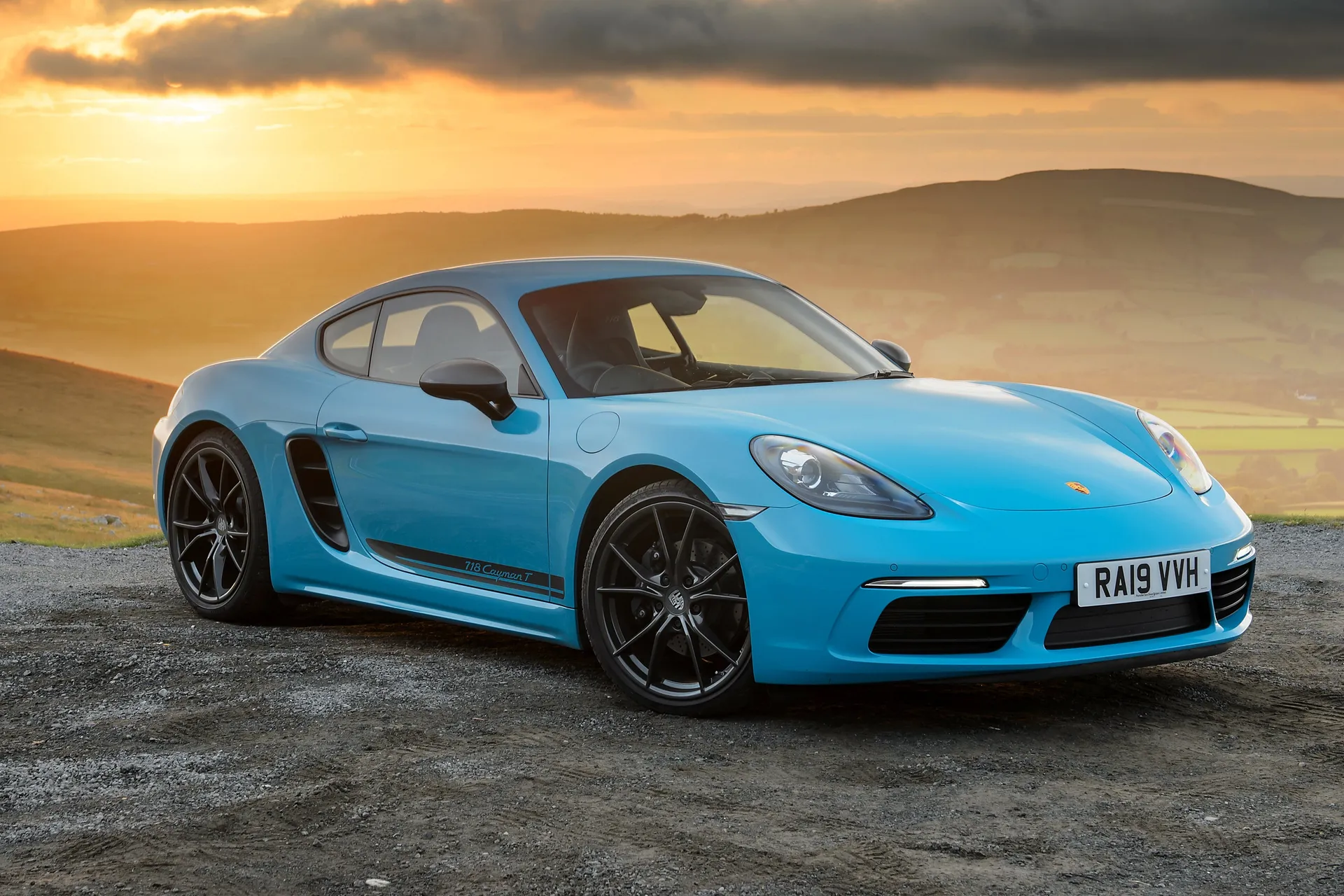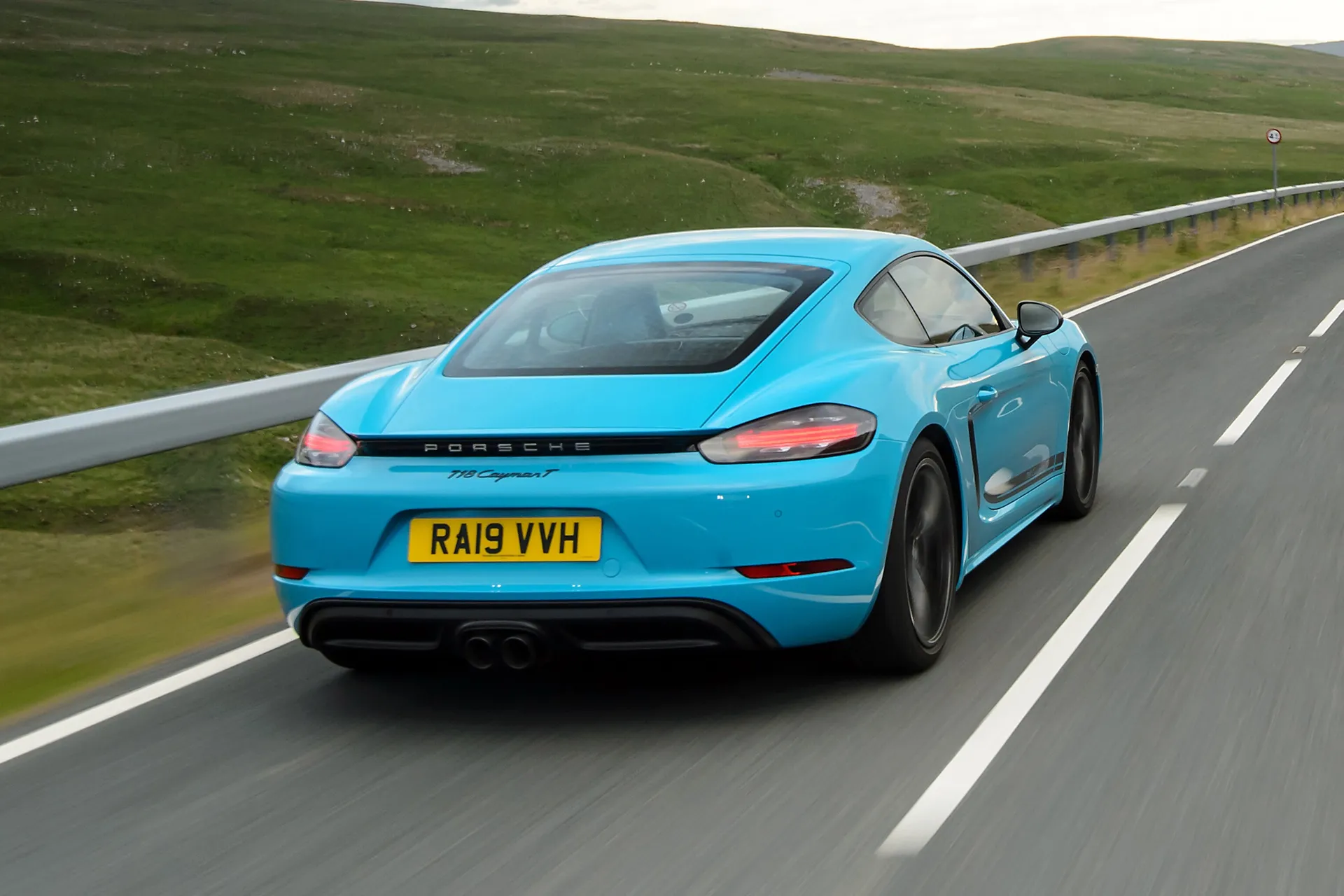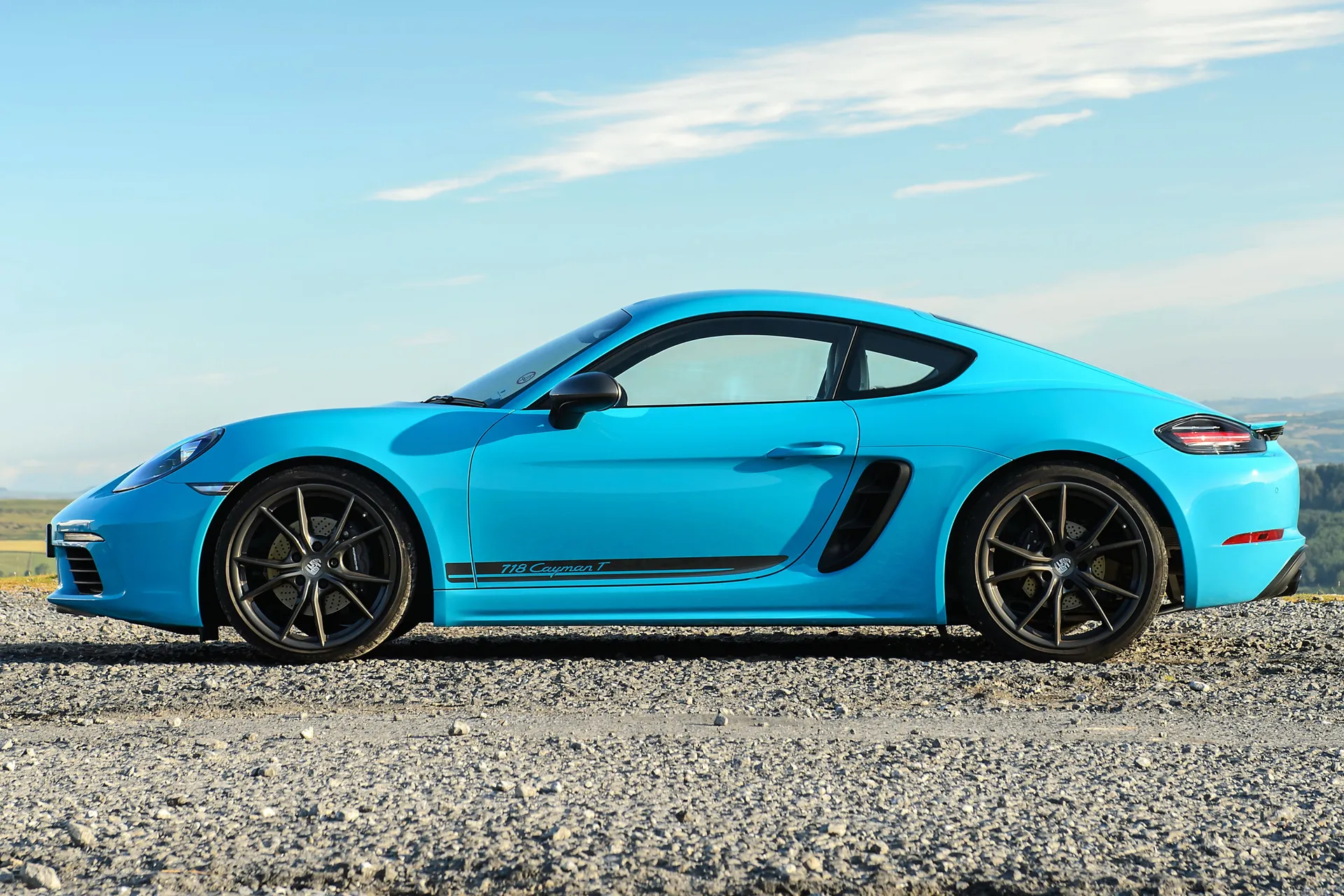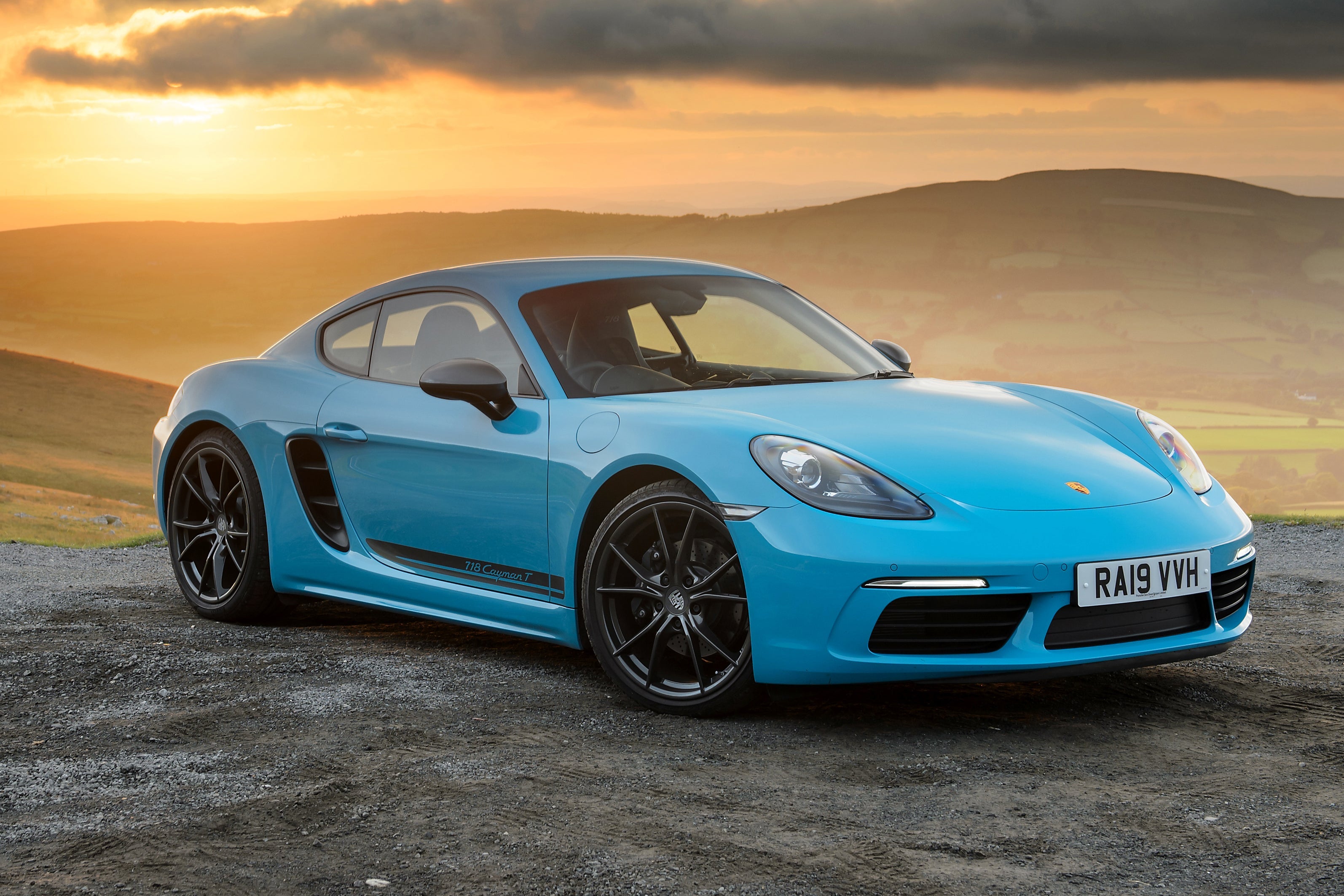Porsche 718 Cayman Review 2024
Written by Andrew Brady
Quick overview
Pros
- Incredible poise, balance and agility mixed with good ride comfort
- The engine in the GTS is sensational
- Surprisingly useable day-to-day, the 718 Cayman is actually quite practical with two useful luggage compartments
Cons
- Those four-cylinder engines offer plenty performance, but don’t sound particularly good
- You’ll end up spending a good bit more on the plentiful options list
- Switch to turbocharged four-cylinder engines was for economy, and it’s not really worked
Overall verdict on the 2022 Porsche 718 Cayman
"In this 2022 Porsche 718 Cayman review we are looking at the gold standard of sportscars. It's not cheap to buy even at the bottom of the range, but the levels of agility, balance, fun and sheer engineering quality see it compete on terms with cars costing twice as much. Better still, Porsche added the GTS model which offers a 4.0-litre naturally aspirated six-cylinder engine, silencing at a stroke the only possible criticism of the original car. If you can afford it, don't bother looking elsewhere - this is the one."

It took Porsche eight years after launching its Boxster to offer the popular, entry-level sportscar as a coupe, but in 2005 the Porsche Cayman was finally launched in 987 form. It’s been a mainstay in the range, since, right up to the current 981 model, which now is priced slightly below the Boxster in the line-up. Like its open Boxster relation, the Porsche 718 Cayman is the sportscar yardstick, being the car which all its rivals have to beat in the class, but few come close. It's one of the best sports cars you can buy.
Unsurprisingly, there’s a Cayman coupe version of all the Porsche 718 Boxster models, so the range starts with the base Porsche 718 Cayman followed by the Porsche 718 Cayman T, Porsche 718 Cayman S then the Porsche 718 Cayman GTS 4.0. Above that there’s a Porsche 718 Cayman GT4, built by Porsche’s Motorsport department, and different enough to warrant its own report.
The 718 badge was introduced in 2016, it denoting the switch from flat-six naturally-aspirated engines, to turbocharged flat-four engines. If you’re well-read on Porsche history then you’ll know Porsche 718 was a successful four-cylinder powered racing model in the late 1950s, though even that retrospective nod isn’t enough to convince some of Porsche’s most hardcore fans that a four-cylinder Cayman is right. To appease that small, vociferous fan base Porsche reneged, adding the GTS 4.0 into the range in 2020, with a slightly de-tuned version of the 4.0-litre flat-six from its range-topping GT4 model.
For everyone else the engines are made up of a choice of turbocharged flat-four engines, of either 2.0-litre capacity in the Porsche 718 Cayman or Cayman T, and a 2.5-litre version powering the Porsche 718 Cayman S. With more power than the engines they replaced, as well as the hope of improved economy and emissions, most buyers will be more than happy with the smaller powerplants. Like the six-cylinder units they replaced, the turbocharged four-cylinder engines are still placed right in the middle of the car.
That engine placement is crucial to how well the Porsche 718 Cayman drives, it situated low and right between the axles, creating perfect balance, which is to the enormous benefit of agility.
Drive any Porsche 718 Cayman, even the most modestly powered model, and it’ll make other cars feel mute in their responses, with the quick, accurate steering, fine ride and the superb poise defining how it goes down the road. They are exceptional to drive, and with two luggage areas – one front, the other at the back – they’re also surprisingly practical for a two-seat sportscar.
That usability means the Porsche 718 Cayman doesn’t need to be a weekend plaything, but can be used as your everyday car, which might dictate your choice of transmission. The Porsche 718 Cayman is offered with either a six-speed manual or a seven-speed twin-clutch automatic gearbox, the former so good it’s difficult not to recommend, but that automatic, referred to as PDK, does make the Porsche 718 Cayman both slightly quicker as well as a bit easier in traffic.
Add the kudos of the Porsche brand to the Porsche 718 Cayman’s good looks and its class-leading driving dynamics, and it’s little wonder it’s so dominant against its sportscar rivals, and indeed, good enough to humble many cars costing significantly more.
heycar has 1000s of used cars for sale, including a wide range of Porsche Caymans for sale. If you're looking for the older version, you need our Porsche Cayman (2013-2016) review.
Is the Porsche 718 Cayman right for you?
Emphatically, yes. If you’re even considering a sportscar then the Porsche 718 Cayman should be on your list, and, really, it should be right at the top of it. To drive it betters all its rivals, though we concede that the Alpine A110 does run it close here, the allure of the Porsche badge allied to the Porsche 718 Cayman’s good looks, as well as the easy availability of Porsche dealerships and specialists to maintain it, makes the Porsche 718 Cayman difficult to ignore.
Add a degree of practicality, within the constraints of a two-seat sportscar, and we’re surprised anybody buys anything else. Indeed, one of the only things going against it is its omnipresence, buying a Porsche 718 Cayman (or its Porsche 718 Boxster relation) not exactly marking you out from the crowd – if you want that then the Alpine A110 is more likely to appeal. We’d buy the Porsche, though, and we’d heartily recommend you do so, too.
What other cars are similar to the 718 Cayman?
Obviously there’s the option of its Porsche 718 Boxster relation, if you’re after an open-topped car, but otherwise direct rivals are relatively few if you’re after a small coupe.
The Alpine A110 is the closest rival, to drive at least, it lacking the brand pull of the Porsche, and its interior is woeful in comparison, likewise anything from Lotus in the Porsche 718 Cayman’s price bracket. Others you might consider are the BMW 2 Series Coupe and its BMW M2 flagship, the Jaguar F-Type coupe, or Audi TT coupe. Both the BMW and Audi rivals are more practical choices, as they come with a pair of additional seats (albeit in a +2 guise in the TT).
Comfort and design: Porsche 718 Cayman interior
"Sitting low in the cabin, in the standard Sports Seats with two-way electrical adjustment, you’ll find a very comfortable driving position in the Porsche 718 Cayman. Those seats are standard in the Porsche 718 Cayman and Porsche 718 Cayman S, with a slightly deeper, shapelier Sports Seats Plus (again with two-way electrical adjustment fitted to the more driver-focussed Porsche 718 Cayman T and 718 Cayman GTS 4.0 models as standard. "

It’s possible to add 14-way electrical adjustment to the Sports Seats, with additional electrical adjustment also offered on the Sports Seats Plus, it gaining 18-way movement.
There’s the option of Sport Bucket Seats or Full Bucket Seats, these offering superb support and comfort, though being a bit trickier to clamber in and out of. Pick those more sporting bucket seats and you lose the availability of optional seat heating or ventilation.
The steering column adjusts for reach and rake, while Porsche offers a choice of steering wheels, one being heated. Two-zone climate control is an option, indeed, the options list is lengthy, offering a huge scope of colour choices, material finishes including leather, carbon fibre, wood and metal, though fundamentally the cabin design remains the same in all.
Ahead of you the pair of analogue instruments are clear, with the rev-counter dominating, with the third roundel ahead of you having a digital screen that can show anything from engine temperatures, to infotainment or navigation features. The dashboard is unfussy in its design throughout, with the cabin dissected by the centre console containing the gear selector for either the PDK or manual transmission, placing it within easy reach of the steering wheel.
Quality and finish
It wears a premium badge on its bonnet, and the interior largely lives up to that billing. You do have to spend some extra money on options for it to look and feel its very best, though. We’d recommend the extended leather interior package, as it replaces the top portion of the dash, as well as the tops of the doors inside with leather, lifting the interior considerably. It’s not a cheap at a little over £2,500, but it elevates the cabin from merely nice to something very special.
The materials used throughout all feel of high quality, the fit and finish very well executed, feeling like it’s built to last. The only exception is the cupholders, which pop out of the dashboard above the glovebox, and feel flimsy and aren’t great at their intended purpose. Best stick to having your coffee in, rather than to go, then. A fine mix of driver focus and ease of use, mixed with certain longevity and nice tactile materials throughout, otherwise, the Porsche 718 Cayman’s cabin is an appealing place to be.
Infotainment: Touchscreen, USB, nav and stereo in the Porsche 718 Cayman
As standard all Porsche 718 Cayman feature a 7-inch touchscreen called Porsche Communication Management. It’s easy to operate, either via the screen itself, with some of its functionality replicated within the supplementary screen in the instruments - though you need to option the multifunction wheel to do so - as well as some additional controls underneath the main screen.
Its functionality includes navigation, mobile phone connection, audio connection and a voice control system, with additional features under Porsche’s Carfinder subscription service adding remote vehicle status and vehicle tracking. There’s Apple CarPlay as standard, too, Porsche not supporting Android Auto, because it states that the majority of its customers use Apple smartphones.
As you might expect there’s the ability to upgrade the standard audio system from the 110 watt, six-speaker DAB system to a BOSE option which ups that output to 505 watts and ten speakers, or a range-topping Burmester surround sound system for 821 watts and 12 speakers with surround sound.
If you’re ordering a Porsche 718 Cayman T, don’t forget to re-check the option box to have the stereo re-instated, it coming as standard without it in a bid to save weight, but it’s a no-cost option to have it fitted.
Space and practicality: Porsche 718 Cayman boot space
The Porsche 718 Cayman is a sportscar, and that brings with it a certain expectation of some compromises, but for two adults it’s perfectly comfortable and not lacking in space.
A decent-sized glovebox is ahead of the passenger, with the doors have bins for oddment storage with useful pull-out sides, but even with the easy access, the space behind isn’t huge. There’s a little recess in the transmission tunnel between the seats, too, but again, it’s not hugely useful, though one option is, Porsche offering a little storage net in the front passenger-side footwell that costs nothing on the options list to add. Do so.
Where the Porsche 718 Cayman gains over its Porsche 718 Boxster relation is in luggage space. It shares the same usefully shaped 150-litre capacity front luggage compartment which will swallow a couple of carry-on bags, but also gains in the rear compartment due to its obvious lack of a folding convertible roof. Not only is the rear boot larger (by 150 litres) to offer 275 litres of volume, but it’s accessed by a large opening hatchback.
That rear boot still won’t swallow a bike (like you can manage in a TT), but with clever packing and soft bags you’ll get a surprising amount in. Being a coupe, too, there’s always room for a bike, or skis, on a roof-rack, and because sportscars look epic when they’re carrying your gear on the roof.
As a daily, useful driver, then the Porsche 718 Cayman is capable with a few provisos, and if you need to do the school run (with one child only, admittedly) then there’s the option of an ISOFIX child seat mount on the passenger side seat – though not if you’ve optioned the more extreme bucket seat choices.
The Porsche 718 Cayman dimensions are 4379mm long, 1994mm wide and 1295mm tall.
Handling and ride quality: What is the Porsche 718 Cayman like to drive?
"There really isn’t a weak point in the line-up in relation to the ride and handling, even the lowliest entry-level model offering the sort of agility and engagement that marks the Porsche 718 Cayman as the driver’s choice in the category it competes in."

As ever, though, there are degrees of that, Porsche offering plenty of choices to sharpen that drive up even further, either by the selection of individual cost options, or picking a model that’s already been specified with them.
The base Porsche 718 Cayman and Porsche 718 Cayman S come with standard, passive suspension, riding on 18-inch wheels in the entry-level car, and 19-inch ones on the Porsche 718 Cayman S. To that you can add PASM (Porsche Active Suspension Management) and/or a Sports Chassis which drops the ride height further, as well as the choice of bigger wheel options.
The Porsche 718 Cayman T gains all of those, as well Porsche’s Sports Chrono package and a mechanical limited-slip differential with Porsche Torque Vectoring (PTV). That combination creates a Porsche 18 Cayman that feels even more alert and eager to turn in, without sacrificing too much in the way of ride comfort. The Porsche 718 Cayman GTS 4.0 uses much the same set-up as the T, only it’s got the substantially more powerful engine to really enjoy the fine balance on offer.
Don’t write off those four-cylinder engines, though, indeed, by not being the main event they only further illustrate how capable and enjoyable the Porsche 718 Cayman’s chassis is – even in standard form. The steering offers lovely weighting and crisp, precise response, grip levels are high, but there’s adjustability should you want it, the connected feeling you have with the chassis being key in the Porsche 718 Cayman’s driver appeal. The brakes are mighty in all versions too.
What engines and gearboxes are available in the Porsche 718 Cayman?
Die-hard Porsche fans might have lamented the company’s decision to replace the six-cylinder engines with four-cylinder ones, and the corresponding 718 badge addition, but for most buyers it’s unlikely to be an issue. Indeed, both the 2.0-litre and 2.5-litre turbocharged flat-four engines deliver more useable performance, with greater low rev flexibility, but still allied with an appetite for revs that appeals to more enthusiastic drivers.
The 2.0-litre engine provides 300PS and 380Nm of torque, while the 2.5-litre engine ups that to 350PS and 420Nm of torque. The four-cylinder engines sound better (though still not brilliant) when optioned with a sports exhaust. For sound, and superb high-revving flat-six thrills, only the awesome GTS 4.0 will do.
Optioning Porsche’s Sports Chrono package increases the performance and focus in all, upping shift speeds in the PDK automatic transmission, adding a Mode Switch for the drive modes to the steering wheel, blipping the throttle for smoother downshifts with the manual and adding a bit more configurability to all the systems.
Sports Chrono also adds Launch Control mode and various options that are useful if you want to take your Porsche 718 Cayman to a circuit. Sport Chrono/PDK equipped cars are slightly quicker to 62mph as a result of the additional features, but none are slow, with even the Porsche 718 Cayman able to reach 62mph in 5.3 seconds and manage a 170mph top speed.
The Porsche 718 Cayman S with PDK and Sport Chrono is actually marginally quicker to 62mph than the GTS 4.0, despite the 4.0’s 400PS, that down to the GTS’s standard fitment (for now, a PDK due late 2020) of a manual transmission.
The manual transmission might be a touch slower, but if you miss old-school driving fun then you’ll love the six-speed gearbox in the Porsche 718 Cayman. It’s quick and light, and the clutch, and other pedals well positioned and weighted to really allow you to enjoy it. PDK adds convenience, and another ratio for a total of seven gears, it an excellent transmission if you prefer the ease it brings.
Refinement and noise levels
Given its driver focus all Porsche 718 Cayman offer decent refinement, both from wind and road, as well as self-generated sounds from the engine. They’re there when you want them, adding the Sports Exhaust bringing more aural excitement, though being switchable, means you can mute those more overtly sporting sounds when you’re on a longer drive.
Wind noise is well suppressed, it quieter here than its open-topped Porsche 718 Boxster relation, though the Porsche 718 Cayman still suffers from a degree of tyre noise, particularly on rougher road surfaces. It’s a touch more obvious with more focused cars like the T or GTS, riding on larger wheels and tyres, but that small trade off in refinement is more than compensated for by the gains made in the way it drives. For a sportscar though, the Porsche 718 Cayman is refined.
Safety equipment: How safe is the Porsche 718 Cayman?
No independent crash tests of the Porsche 718 Cayman have been undertaken, but it complies with all global standards for crash protection. There are a pair of front and front passenger full-sized airbags, while all Porsche 718 Cayman models also feature Porsche Side Impact Protection (POSIP).
This comprises of side impact protection elements in each door, a thorax airbag in each outer backrest side bolster and head airbags in the door panels. If you option Sports Bucket, or Full Bucket seats, you lose the thorax airbags, as well as not being able to option an ISOFIX child seat mount for the passenger seat.
In addition to those safety devices the Porsche 718 Cayman’s stability and traction control systems should help you avoid an accident in the first place, as should the standard anti-lock braking system. Tyre pressure monitoring comes as standard, as do standard bi-xenon headlights with LED daytime running lights, Porsche offering a number of headlight upgrades on its options list.
There’s the option, too, of parking sensors or a rear parking camera, and if you’ve specified the PDK automatic transmission you can also option Adaptive Cruise Control. A camera-based traffic sign recognition system is also available, but the Porsche 718 Cayman isn’t able to be specified with the sort of advanced driver assistance systems that take over, though Lane Change Assist, a blind-spot warning system is now available.
MPG and fuel costs: What does a Porsche 718 Cayman cost to run?
"Those turbocharged engines replaced the six-cylinder engines in a bid to improve ecomomy, and while on paper they have, the reality isn’t quite as convincing. Tested to the tougher WLTP standards the Porsche 718 Cayman manages a combined consumption of 31.4-32.8mpg for the model range, with CO2 of 205-197g/km. The T falls within that, with the Porsche 718 Cayman S being 29.1mpg and CO2 of 222g/km."

There are slight variances in these figures depending on the selected options, things like wheel sizes and whether you’ve opted for the manual or PDK automatic transmission. The Porsche 718 Cayman GTS 4.0 returns 25.9mpg and 247g/km, all these figures likely to be optimistic if you’re driving it as intended, though achievable, and even on occasion, surpassed on a longer cruise.
Insurance groups and costs
Porsche insurance is never going to be cheap, but if you can park it overnight in a garage, or at least off the street it’ll help. All are in the mid- to high 40 insurance group. Other costs will be more than its rivals, Porsche servicing not inexpensive, though there are plenty of specialists who can service it for you if you’re unconcerned about main dealer stamps in your service book, or it’s a little bit older.
VED car tax: What is the annual road tax on a Porsche 718 Cayman?
Every model is in excess of the £40,000 list price VED penalty charge, so you’ll pay an additional £355 a year – so £520 annually – for the first five years of ownership, after that it’ll be £165 a year. The first year payment in all the four-cylinder cars is £1,420 with the GTS costing £2,015.
How much should you be paying for a used Porsche 718 Cayman?
"With the earliest Porsche 718 Cayman models now four years old, the price spectrum in the used marketplace is fairly wide, from a starting point of around £35,000, rising to delivery mileage stock at new prices at Porsche dealerships."

The more powerful S is anywhere between £5,000-10,000 more in the classifieds, and Ts remain relative rare presently as it was introduced to the line up a couple of years after the Porsche 718 Cayman and Cayman S. GTS models in the classifieds will be with the 2.5-litre engine from the S, the flat-six 4.0-litre GTS model only arriving in the line-up early 2020.
Worthwhile options include PASM, Sport Chrono, Bose audio, Park Assist and extended leather. There’s no price variable between the PDK and manual car in the classifieds, despite a £2,000 price premium for the automatic when new.
Trim levels and standard equipment
The Porsche 718 Cayman and Porsche 718 Cayman T are both fitted with a 2.0-litre 300PS turbo engine.
The Porsche 718 Cayman S has a 2.5-litre turbo engine with 350PS
The Porsche 718 Boxster GTS 4.0, from 2020 onwards, has a 4.0-litre flat-six engine with 400PS. Until late 2020 it’s only available with the six-speed manual transmission, after which a seven-speed PDK
Standard equipment in all models includes Porsche’s PCM infotainment system, alloy wheels, air conditioning, a manual transmission and Sports Seats with two-way electric adjustment (Sports Seats Plus in the T and GTS).
Ask the heycar experts: common questions
How much does a Porsche 718 Cayman cost?
Is the Porsche 718 the same as the Cayman?
Is the Porsche 718 Cayman fast?
Get our latest advice, news and offers
Keep me updated by email with the latest advice, news and offers from heycar.
By submitting you agree to our privacy policy



